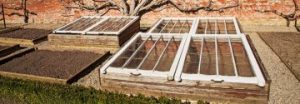
R2102 – Describe the Creation of Hot Beds
The hot bed is a traditional gardening technique that has regained popularity in recent years.
“Hotbeds are special beds in which the temperature is raised above the normal by heat obtained from fermenting material… Hotbeds are occasionally made for encouraging growth of tender plants in the open but find their chief application for plants under cloches, in frames, or in glass-houses. They are extremely useful, especially in spring, for forwarding early vegetables, for propagating and growing-on all sorts of soft-wooded plants, and for the cultivation of such plants as cucumbers and melons, for they provide both moist and a genial temperature, without, if properly made, the great fluctuations to which normal soil is subject. Cuttings of bedding plants produce roots more readily and grow faster on a hotbed that if merely placed in a structure with fire-heat.” The Royal Horticultural Society Dictionary of Gardening, Volume II, 1951
A hot bed uses the heat from decomposing organic matter to raise the temperature of soil in an enclosed space, in order to extend the growing season.
Hot beds are often used to get an early start on seed sowing in spring, but they may also be used to grow salad crops in winter or to grow crops that the local climate would normally be too cold to support.
A hot bed provides bottom heat, using manure rather than electricity as the heat source. As the manure decomposes it generates a substantial amount of heat. The heat is generated by micr-organisms such as bacteria and fungi as the work to decompose the organic matter. The heat source in a hot bed is often fresh strawy manure, although the RHS examiners suggest a mixture of leaves and manure. The addition of leaves makes the heating process slower and helps to prevent the hot bed from overheating.
Instructions for preparing a hot bed in a cold frame:
-
- Construct three sides of the cold frame in February.
- Begin preparing the bed in March – spread strawy manure evenly to a depth of 60 – 75 cm in the bottom of the frame (or you can use a mixture of leaves and manure, as discussed above).
- Cover the manure with topsoil to a depth of 20 – 30cm. An alternative growing medium made up of a mixture of top soil and garden compost (ratio 1:1) may also be used.
- Place the fourth side of the frame in position.
- Put the top of the cold frame over the bed. This should be sloping.
- You can make your hot-bed of any size, as long as the ratio of manure to growing medium is kept at 3:1. If you do decide to make the hot bed deeper, temperatures may rise above the optimum (24oC) and plants may be scorched. If this happens, the bed can be cooled down by adding water or leaves and garden debris to the mixture.
- Leave the hot bed for a week to warm up before use.
-
- Check temperatures regularly with a thermometer to ensure the bed is not too hot or cooling down too much.
- The manure should be tamped down well with boots to compact it, ensuring a more even release of heat.
- A hot bed can be made in a greenhouse or outdoors. If your hot bed is outside, it will need some insulation – for example, wooden sides and a cover to provide some protection.
- A hot bed can also be created in a pit (see below).
- Seed can be sown direct in the soil layer, or in trays placed on top.

Image from: L. H. Bailey Garden-Making, The Macmillan Company, 1898.


